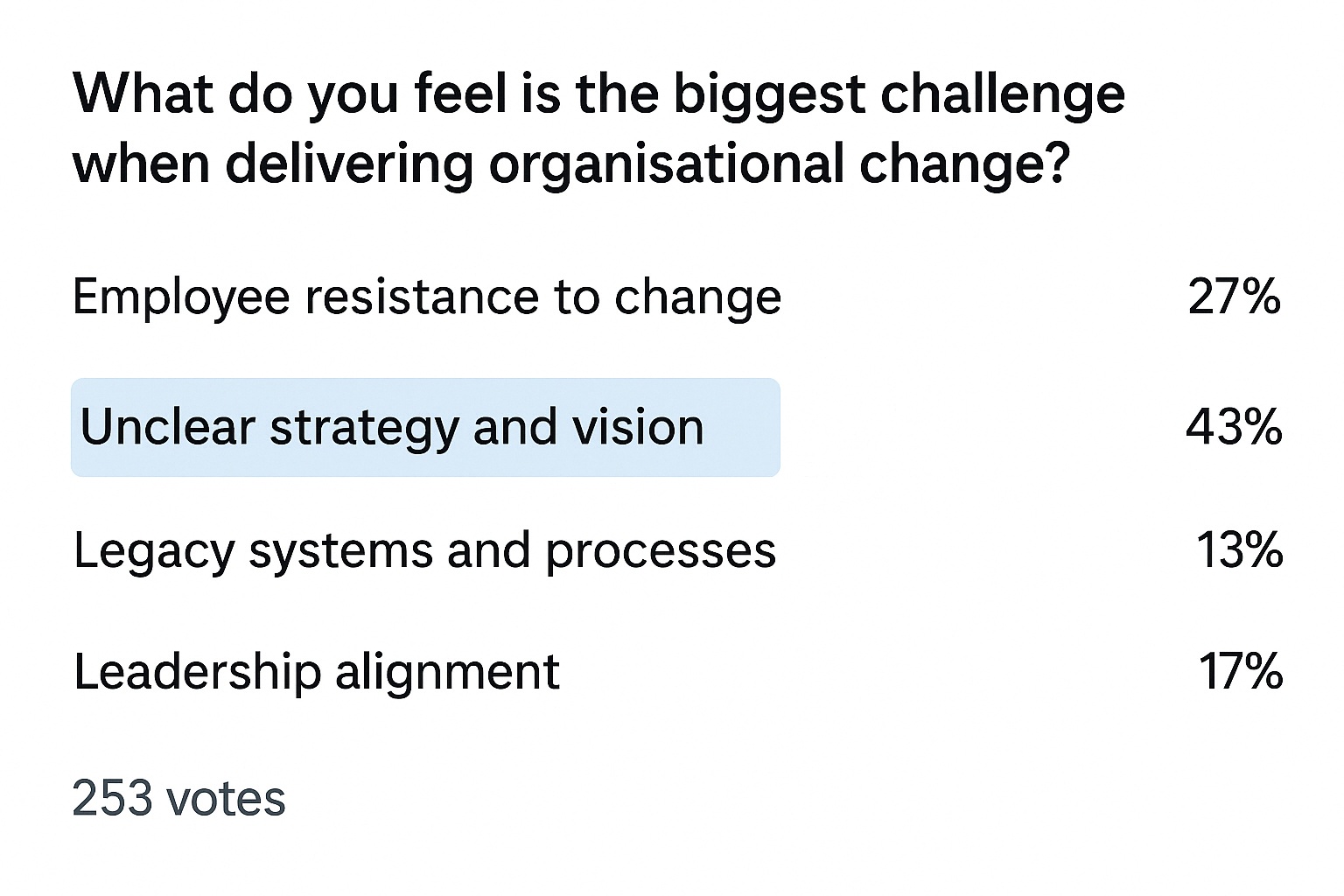Digital transformation has become a strategic imperative for UK organisations, yet despite record investment levels, success rates remain stubbornly low. The root cause isn't technological capability but insufficient focus on the human dimension. This article explores why people are the true differentiator in transformation outcomes and offers a framework for building talent-centred digital change strategies that deliver lasting business value.
Digital transformation has become a strategic imperative across the UK economy. From financial services institutions modernising legacy systems to manufacturers implementing smart factory initiatives, organisations are investing unprecedented resources in technological evolution.
The investment figures tell a compelling story. As of April 2025, the UK digital transformation market is projected to reach approximately £54.3 billion, reflecting a 14.72% compound annual growth rate (CAGR) from 2024 to 2029, and approximately 80% of UK businesses anticipate increasing their IT spending over the next 12 months. According to IDC research, digital transformation spending in the EMEA region is projected to exceed £1.2 trillion by 2028.
Yet despite this financial commitment and executive emphasis, the success rate remains stubbornly low. According to McKinsey's research, an estimated 90% of organisations are currently undergoing some form of digital transformation. In the UK specifically, a recent survey of 450 business leaders found that 68% rated their transformation initiatives as "not fully meeting expectations" in terms of ROI, timeline, or business impact.
The challenge is particularly acute in the UK market, where several factors compound the difficulty:
- A persistent digital skills gap that outpaces educational pipeline development
- Post-Brexit talent mobility restrictions affecting specialised technical recruitment
- Legacy infrastructure in established sectors requiring complex integration capabilities
- Accelerating technology adoption creating unprecedented pressure on existing teams
Amidst these challenges, a clear pattern emerges. The consistent factor in transformation underperformance isn't technological capability, it's the human dimension.
Digital transformation is often conceptualised primarily as a technology upgrade. This technology-centric framing creates a fundamental illusion: that implementing the right technology stack will naturally deliver promised business outcomes. When examining root causes of transformation failure, technology implementation rarely appears as the primary factor. Instead, analyses consistently highlight human and organisational elements.
Research from the Project Management Institute corroborates this pattern, finding that the top three reasons for digital transformation failure are all people-related: inadequate change management (41%), insufficient skill sets (38%), and resistance to change (35%). Technology implementation challenges rank substantially lower at 21%.
Cultural issues remain a significant barrier, contributing to the failure of 70% of digital transformations.
Despite this evidence, workforce strategy is frequently treated as secondary to technology selection. Organisations typically allocate 60-70% of transformation budgets to technology and external consultants, while investing comparatively little in developing internal capabilities and change enablement. According to Deloitte's research, UK organisations spend on average three times more on technology than on the people needed to implement and operate it effectively.
This imbalance creates a predictable pattern: substantial investments in sophisticated technologies that remain underutilised or inadequately implemented because the human elements weren't sufficiently addressed. The result? Expensive tools with low adoption rates, delayed timelines, missed targets, and eventually, transformation initiatives that deliver only a fraction of their potential value.
We asked our LinkedIn audience, what do you feel is the biggest challenge when delivering organisational change?

The Talent Gap Undermining UK Digital Ambitions
The UK faces a particularly challenging digital transformation landscape due to a significant and persistent skills gap. According to the Department for Digital, Culture, Media and Sport, 82% of UK job postings now require digital skills to some degree. Yet the supply of talent hasn't kept pace with this accelerating demand.
Research by TechNation indicates that 93% of UK businesses report significant difficulty hiring for technology roles, with vacancies for data scientists, cloud architects, cybersecurity specialists, and full-stack developers remaining open for an average of 60-80 days, nearly twice the duration of other professional roles.
The digital skills gap is estimated to cost the UK economy £63 billion per year. For mid-market companies with constrained resources, this premium represents a significant barrier to transformation progress.
This national skills shortage manifests differently across sectors:
Financial Services: The UK's financial institutions find themselves competing not only with each other for digital talent but increasingly with fintech disruptors offering innovative work environments and equity opportunities. Legacy modernisation projects require rare combinations of traditional banking knowledge and modern technology expertise.
Manufacturing: The transition to smart manufacturing requires integrating operational technology with information technology, a specialised skill set in extremely limited supply across the UK market. This sector particularly struggles with roles bridging engineering and digital domains.
Retail: Omnichannel transformation demands expertise in customer experience, data analytics, and supply chain integration that traditionally existed separately. Retailers struggle to find professionals who understand both physical store environments and digital customer journeys while competing with e-commerce platforms for scarce talent.
Healthcare: NHS digitalisation and private healthcare technology initiatives face unique regulatory and integration challenges, requiring specialists who understand both clinical contexts and technical implementation. These hybrid skill sets remain exceptionally scarce despite growing demand.
Public Sector: Government digital transformation encounters particular challenges around legacy system modernisation, secure cloud migration, and balancing innovation with strict compliance requirements.
This talent gap isn't merely about headcount but about specialised capabilities aligned with transformation objectives. Internal teams may excel at maintaining business-as-usual operations, but digital transformation requires different competencies:
- The ability to bridge business strategy and technical implementation
- Experience navigating uncertainty while maintaining delivery momentum
- Expertise in integrating emerging technologies with legacy environments
- Skills in influencing cross-functional stakeholders without direct authority
These transformation-specific skills rarely develop organically within organisations focused on operational stability.
Why Internal Talent Models Are Under Strain
The structure of many internal talent acquisition functions reflects their historical development: optimised for predictable, volume-based hiring against clearly defined role profiles. However, digital transformation creates fundamentally different talent acquisition challenges.
Digital transformation hiring is distinctly different in several critical dimensions:
Technical Specialisation: Digital roles require precise technical stack alignment and domain-specific experience that exceeds the technical evaluation capabilities of many internal recruitment teams.
Accelerated Evolution: Digital skills requirements evolve at unprecedented speed. Internal role frameworks and evaluation criteria struggle to keep pace with this rapid evolution.
Competitive Dynamics: When high-value candidates enter the market, they typically receive multiple offers within days, a timeline incompatible with traditional corporate recruitment cycles.
These distinctions create significant strain on internal talent acquisition functions. Many internal recruitment teams lack the technical depth to effectively evaluate specialised digital capabilities. The standard corporate recruitment timeline, often spanning 4-6 weeks, proves too lengthy for competitive digital hiring.
For organisations undertaking digital transformation, these limitations create a serious strategic vulnerability. The evidence appears in extended vacancy durations for critical transformation roles, compromised hiring decisions based on limited candidate pools, and the significant opportunity costs when transformation initiatives stall due to capability gaps.
Learn how our Contract Managed Service can help you cut contractor costs, ensure compliance, and drive consistency across your workforce with our cost-saving infographic.
Organisations successfully navigating digital transformation have recognised that talent strategy must be elevated from a support function to a core strategic pillar. They exhibit several distinctive approaches:
Strategic Workforce Planning Integration
Successful transformation leaders embed workforce planning directly into transformation roadmaps rather than treating hiring as an afterthought:
- They map capability requirements against transformation phases, identifying not just immediate hiring needs but the evolution of skill requirements
- They conduct detailed skills inventories to identify internal capabilities that can be developed or redeployed
- They create talent risk assessments for transformation roadmaps, identifying where skill shortages could undermine critical path activities
Proactive Capability Development
Rather than reactive hiring when needs become urgent, successful organisations build transformation capabilities ahead of demand:
- They identify and resource programme-critical roles early in the transformation journey
- They establish transformation enablement teams combining technical and change management expertise before large-scale rollout
- They develop internal talent through targeted upskilling programmes aligned with transformation technologies
Flexible Talent Operating Models
Recognising that traditional permanent hiring cannot address all transformation needs, successful organisations adopt blended approaches to talent. They differentiate between capability types needed for successful transformation:
- Core capabilities requiring permanent internal expertise
- Transitional capabilities needed primarily during implementation
- Specialised capabilities required intermittently or for specific challenges
- Leadership capabilities to guide and sustain transformation momentum
For each capability type, they develop appropriate resourcing strategies combining permanent hires, contract specialists, consulting partners, and strategic recruitment relationships.
Transformation-Aligned Talent Acquisition
Organisations successful in digital transformation reconfigure their talent acquisition approach:
- They establish dedicated transformation recruitment capability either internally or through specialist partners
- They develop talent intelligence functions that continuously map the market for transformation skills
- They create compelling employer value propositions specifically addressing what motivates digital talent
These approaches represent a fundamental shift from treating recruitment as a transaction service to positioning talent strategy as a core enabler of transformation success. The organisations demonstrating consistent transformation success recognise that people, not platforms, ultimately determine outcomes.
Here is
Lara Webb's, Founder of TRIA, insight on approaching digital transformation:
Developing a people-first transformation strategy requires systematic examination of how talent considerations integrate with technological and operational changes. Five crucial questions provide a framework:
1. Do we understand the specific roles and capabilities that will shape transformation success?
Many organisations approach transformation hiring with insufficient precision, seeking generic digital skills without clarifying exactly how these capabilities connect to business outcomes.
A more effective approach begins with capability mapping, a systematic analysis of what specific skills will unlock transformation value at each phase. This mapping exercise identifies the critical roles that disproportionately influence transformation success, including:
- Translational leadership roles that bridge business strategy and technical implementation
- Integration specialists who connect new digital capabilities with existing systems
- Change enablement roles that support the human transition to new ways of working
- Technical platform expertise specific to the transformation technologies being implemented
By identifying these critical capabilities with precision, organisations can focus recruitment resources where they will deliver maximum transformation impact.
2. Where do our internal strengths lie, and where do we need external support?
Effective transformation requires honest assessment of internal capabilities. Conducting a comprehensive capability audit provides crucial insight, examining:
- Technical depth in transformation technologies
- Change leadership capacity
- Learning infrastructure
- Culture alignment with transformation requirements
This assessment provides a foundation for strategic talent decisions, determining where internal development is viable and where external capability is essential.
3. Are we trying to scale digital capability without specialist talent support?
Several factors indicate when specialist talent support becomes essential:
- Volume and specialisation of hiring needs exceed internal recruitment capacity
- Time sensitivity creates urgency beyond standard recruitment timeframes
- Competitive talent dynamics require sophisticated market engagement
- Technical evaluation complexity exceeds internal assessment capabilities
Organisations facing these conditions often benefit from moving beyond exclusively in-house recruitment approaches.
4. Does our employer value proposition resonate with transformation talent?
Research indicates that transformation specialists particularly value:
- Meaningful impact opportunities where their work directly influences important outcomes
- Technical environment quality including modern technology stacks and practices
- Leadership credibility demonstrated through technical understanding and clear vision
- Continuous learning culture supporting professional growth
- Work flexibility that accommodates different productivity patterns
Organisations must honestly assess whether their current EVP addresses these priorities.
5. Do we have the right recruitment partners supporting our transformation?
Effective transformation recruitment partners demonstrate several distinctive characteristics:
- Domain expertise in specific transformation areas
- Advisory capacity that challenges assumptions and provides market insight
- Relationship-based approach focused on long-term partnership
- Established networks within specialist communities
- Quality-focused methodology emphasising candidate alignment and success probability
When organisations implement people-first transformation strategies, the impact manifests across multiple dimensions:
Enabling Strategic Leadership Focus
In people-powered transformations, leadership capacity is protected through strategic talent partnerships, allowing leaders to focus on architectural decisions and stakeholder alignment rather than being consumed by recruitment challenges.
Creating Flexible Capability Models
People-first approaches address workload variability through sophisticated resourcing models, combining core permanent teams with flexible specialist resources to maintain consistent development velocity despite changing priorities.
Accelerating Market Delivery
People-powered transformations typically demonstrate significantly faster time-to-market for new capabilities by leveraging experienced teams that have delivered similar platforms elsewhere, dramatically reducing learning curves.
Ensuring Transformation Continuity
People-first approaches build resilience into transformation programmes through knowledge-sharing frameworks and interim leadership capabilities, preventing the schedule delays that often accompany team transitions.
Enabling Innovation While Maintaining Operations
One of the greatest challenges in transformation is balancing innovation with operational stability. People-powered approaches address this tension through thoughtful team composition:
A UK government agency created a two-track technology organisation with distinct operational and transformational teams. The transformation track leveraged contract specialists with public sector digital experience to drive innovation while the operational track maintained existing services. This dual approach prevented the common pattern where urgent operational needs consistently supersede transformation priorities.
A manufacturing technology leader established an innovation team combining internal subject matter experts with external digital specialists. This hybrid structure ensured that new digital capabilities remained grounded in operational realities while introducing modern approaches that wouldn't have emerged from the internal team alone. The combination delivered a 28% efficiency improvement in production processes within the first year.
The evidence is compelling and consistent. McKinsey's research indicates that transformations emphasising people and change management are 2.6 times more likely to succeed than those focusing predominantly on technology. Deloitte's studies show that organisations prioritising people in digital transformation efforts see significantly higher ROI.
This consistent pattern has profound implications:
Transformation is fundamentally about human adaptation, not just technological implementation. It requires changes in behaviours, mindsets, decision processes, and collaborative patterns across the organisation.
Leadership focus should balance technological and people considerations throughout the transformation journey. When executive attention disproportionately focuses on technology while delegating people aspects to support functions, transformation typically underperforms.
Investment allocation should reflect this balanced perspective. While technology naturally requires significant financial resources, the human elements, talent acquisition, capability development, change enablement, and leadership deserve proportionate investment.
As we enter an era where AI, data, automation, and experience-led delivery increasingly shape competitive differentiation, these principles become even more critical. These advanced technologies amplify rather than diminish the importance of human capabilities.
For executives leading transformation initiatives, this perspective prompts essential questions:
Do you have the people to deliver your transformation vision?
Is your talent strategy receiving the same rigorous attention as your technology strategy?
Are you investing proportionately in the human capabilities required for transformation success?
Digital transformation doesn't start with a platform. It starts with people. And organisations that embrace this reality gain significant advantage in turning transformation ambition into lasting business value.
Connect With Digital Transformation Talent Specialists
Is your organisation struggling to secure the specialised talent needed for digital transformation success? Our strategic recruitment partnerships help bridge the digital skills gap with precision-matched technical specialists, transformation leaders, and change enablers.
Contact our team today to discuss your specific capability requirements and discover how a people-first approach can accelerate your transformation journey here.





